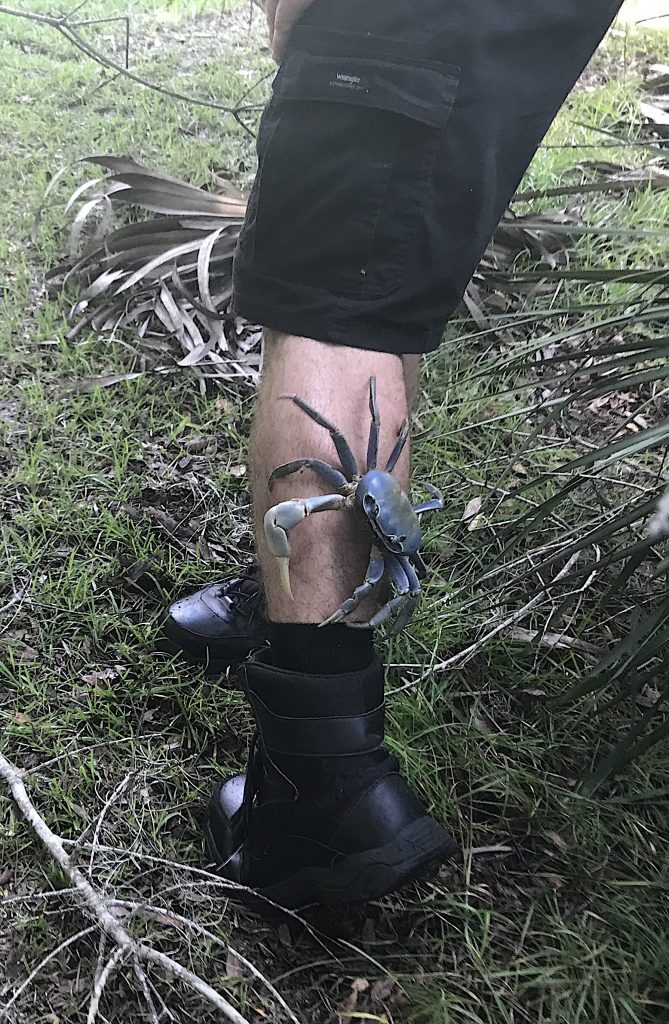
To a startled Land Blue Crab a leg is as good as a tree. Photo by Green Deane
Yes, there are land crabs in Florida and the rest of the gulf coast. Water Blue Crabs are a often seen and caught for food. Land Crabs can be more elusive. Scientifically Cardisoma guanhumi, they are generally considered to be a creature of the southern end of the state and around the gulf to Texas. In Brazil they were a major food source until over harvested. They have been officially reported as far north as Ponce Inlet, which is a little south of Daytona Beach. This specimen was seen in Princess Point Preserve about 50 miles further north… that might be a record. They are out of season from July 1 to October 31st. The limit is 20 per person per day or no more more than 20 in your possession at one time. Also, no person shall harvest or attempt to harvest them on, upon or from the right-of-way of any federal, state or county-maintained road, whether paved or otherwise, or from any state park. Interestingly they are vegetarians but do occasionally eat each other. With one claw larger than the other they can give you a memorable pinch. Cardiosoma means heart-shaped body.
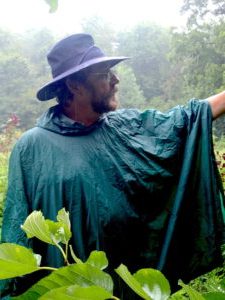
Classes are held rain or shine (but not during hurricanes.)
Foraging Classes: Visiting two areas on the east side of Florida this weekend, Port Orange and West Palm Beach.
Saturday August 7th, Spruce Creek Park, 6250 Ridgewood Ave. Port Orange, 32127. Meet at the pavilion, 9 a.m. to noon.
Sunday August 8th, Dreher Park, 1200 Southern Blvd., West Palm Beach, 33405. 9 a.m. to noon, meet just north of the science center.
Saturday August 14th, Bayshore Live Oak Park, Bayshore Drive. Port Charlotte. 9 a.m. to noon. Meet at the parking lot in the park on Bayshore at Ganyard Street.
Sunday August 15th, Blanchard Park, 10501 Jay Blanchard Trail, Orlando, FL 32817. 9 a.m. till noon. Meet at the pavilion next to the tennis courts.
Sunday August 21st, Eagle Park Lake, 1800 Keene Road, Largo, FL 33771. 9 a.m. to noon. Meet at the pavilion near the dog park.
For more information, to pre-pay or to sign up for a class go here.
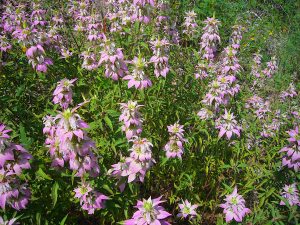
Horsemint (Monarda punctata) will be easy to find for several months. Photo by Green Deane
This is the time of year to go looking for some favored and avoided wild edibles. One usually starts looking for grapes now as their season is usually full swing by early September. In Ft. Pierce last weekend we saw quite a few single-tendril grapes in season. At the above mentioned Princess Point there were ripe forked tendril grapes (which represent the two large grape groups locally.) Also Podocarpus arils are ripening and August is their usual season. They are a very common hedge species. Also easy to find this time of year is Horsemint, its pretty pink bracts make it easy to spot in sandy areas. This past week we also harvested a lot of Chanterelle mushrooms and Milk Caps, choice foraging food. On the other side of the possible menu Saw Palmettos will ripen soon. In a word they taste like vomit. They do, however, have all the essential amino acids humans need.
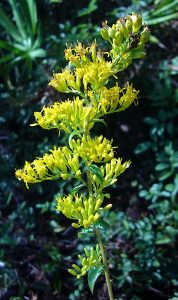
Goldenrod is ruderal. What does that mean? Read the article. Photo by Green Deane
Also seen blooming now is Goldenrod. It is a bit of a treasure hunt and disappointment. The treasure hunt is that one species is better than all the rest for tea, Solidago odora. It does grow here, has an anise flavor, but is hard to find. It’s reported in most counties but is not common. Goldenrod grows in about half of the United States, southwest to northeast. Other Goldenrod species can also be made into tea, perhaps all of them particularly for herbal applications, but they don’t taste anywhere near as good. In fact, after the “Boston Tea Party” of 1773 halted tea imports colonialists drank Goldenrod tea and even exported some to China. It did not catch on. However, every time I see a Goldenrod I pull off a leaf and crush it hoping to detect the tell-tale anise smell. It’s a golden treasure hunt.
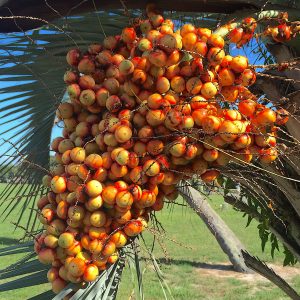
Pindo Palm can fruit almost anytime of year. Photo by Green Deane
When something is ripe or ready to be harvested varies. A window of a few weeks is normal for most species but often can be extended. Pindo Palms can demonstrate that. I normally start looking for Pindo Palm fruit at the end of spring. Memorial Day reminds me their season is coming soon. By June I am usually eating some here and there. We are now early-August and I had my first Pindo Palm fruit today in Central Florida. The palm’s fruit is one of my favorite wild edibles. I definitely do not have a sweet tooth — in fact I carry the gene for fruit sugar intolerance — but Pindo Palm fruit is one I really like so I keep a close eye on them. While they like late spring and early summer you can find an odd one here and there fruiting around Thanksgiving or Valentine’s Day. They are also a hearty palm and can take a lot of cold temperatures.
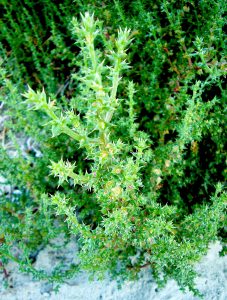
I find Russian Thistles in front of hotels on Daytona Beach. Photo by Green Deane
We shouldn’t forage along railroad tracks and you can blame it all on the Russian Thistle. This species, best known as the tumble weed that rolls across the wild west in movies, came with immigrants to southern South Dakota in the early 1870’s. Best guess is it contaminated their flax seed. By 1895 it reached New Jersey and California. The question was how? A professor who worked for the Department of Agriculture figured out the trains were spreading the seeds coast to coast. It was a remarkable idea at the time and brought him much fame. His solution to the unintentional distribution? Kill plants long railroad tracks. Thus began the practice of putting down some mighty and long-lasting chemicals to kill weeds sprouting amongst the iron rails. Railroad tracks are a good place to find seeds to take home and plant but not to find food. There have even been a few reported deaths from foraging along rail road tracks.

Green Deane videos are now available on a USB.
My nine-DVD set of 135 videos has been phased out and replaced by a 150-video USB. The USB videos are the same videos I have on You Tube. Some people like to have their own copy. The USB videos have to be copied to your computer to play. If you want to order the USB go to the DVD/USB order button on the top right of this page. That will take you to an order form. I’d like to thank all of you who ordered the DVD set over the years which required me to burn over 5,000 DVDs individually.

Green Deane Forum
Want to identify a plant? Perhaps you’re looking for a foraging reference? You might have a UFO, an Unidentified Flowering Object, you want identified. On the Green Deane Forum we — including Green Deane and others from around the world — chat about foraging all year. And it’s not just about warm-weather plants or just North American flora. Many nations share common weeds so there’s a lot to talk. There’s also more than weeds. The reference section has information for foraging around the world. There are also articles on food preservation, and forgotten skills from making bows to fermenting food.

Your donations to upgrade the EatTheWeeds website and fund a book were appreciated. A book manuscript has been turned it. It had 425 articles, 1326 plants and a third of a million words. What it will be when the publisher is done with it next year is unknown. It will be published in the spring of 2023. Writing it took a significant chunk of time out of my life from which I have still not recovered. (Many things got put off.) The next phase is to update all the content on the website between now and publication date. Also note as it states above the 135-video DVD set has been phased out for 150-video USB. Times and formats change. Which reminds me I need to revisit many plants and make some new videos.
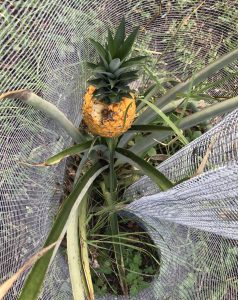
Creature-eaten pineapple.Photo by Green Deane
Incidentally, if you’re patient you can raise pineapples from the tops of pineapples you buy at the store. However, they have to be extremely ripe to be sweet and a lot of creatures like to eat them. Wrapping pineapple in fencing will usually stop raccoons and possums from sampling but not a bird or two. It also take a couple of years to raise them (same with bananas.)
This is weekly newsletter #468. If you want to subscribe to this free newsletter you can find the sign-up form in the menu at the top of the page.
To donate to the Green Deane Newsletter click here.


We have Blue Land crabs, Cardisoma guanhumi up here around the coastal islands East of Savannah, GA. They are rare but it not uncommon to see them or get reports of them. I have personally seen them here since 1968. I love your news letter!! Thanks!!!
My best,
John “Crawfish” Crawford